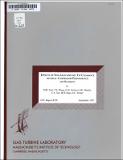| dc.contributor.author | Graf, Martin Bowyer | en_US |
| dc.contributor.author | Wong, Thomas S. (Thomas Sheung) | en_US |
| dc.contributor.author | Greitzer, E. M. (Edward M.), 1941- | en_US |
| dc.contributor.author | Marble, Frank E. | en_US |
| dc.contributor.author | Tan, Choon Sooi | en_US |
| dc.contributor.author | Shin, Hyoun-Woo | en_US |
| dc.contributor.author | Wisler, David C., 1941- | en_US |
| dc.contributor.other | Massachusetts Institute of Technology. Gas Turbine Laboratory | en_US |
| dc.date.accessioned | 2016-10-06T21:22:31Z | |
| dc.date.available | 2016-10-06T21:22:31Z | |
| dc.date.issued | 1997 | en_US |
| dc.identifier.uri | http://hdl.handle.net/1721.1/104762 | |
| dc.description | September 1997 | en_US |
| dc.description | Statement of responsibility on title-page reads: M.B. Graf, T.S. Wong, E.M. Greitzer, F.E. Marble, C.S. Tan, H-W Shin, D.C. Wisler | en_US |
| dc.description | Includes bibliographical references (pages 34-35) | en_US |
| dc.description.abstract | The effects of circumferentially non-uniform tip clearance on axial compressor performance and stability have been investigated experimentally and analytically. A theoretical model for compressor behavior with non-axisymmetric tip clearance has been developed and used to design a series of first-of-a-kind experiments on a four-stage, low speed compressor. The experiments and computational results together show clearly the central physical features and controlling parameters of compressor response to non-axisymmetric tip clearance. It was found that the loss in stall margin was more severe than that estimated based on average clearance. The stall point was, in fact, closer to that obtained with uniform clearance at the maximum clearance level. The circumferential length scale of the tip clearance (and accompanying flow asymmetry) was an important factor in determining the stall margin reduction. | en_US |
| dc.description.abstract | For the same average clearance, the loss in peak pressure rise was 50% higher for an asymmetry with fundamental wavelength equal to the compressor circumference than with wavelength equal to one-half the circumference. The clearance asymmetry had much less of an effect on peak efficiency; the measured maximum efficiency decrease obtained was less than 0.4 percent compared to the 8% decrease in peak pressure rise due to the asymmetric clearance. The efficiency penalty due to non-axisymmetric tip clearance was thus close to that obtained with a uniform clearance at the circumferentially-averaged level. The theoretical model accurately captured the decreases in both steady-state pressure rise and stable operating range which are associated with clearance asymmetry. | en_US |
| dc.description.abstract | It also gave a good description of the observed trends of (i) increasing velocity asymmetry with decreasing compressor flow, and (ii) decreasing effect of clearance asymmetry with decreasing dominant wavelength of the clearance distribution. The time resolved data showed that the spatial structure of the pre-stall propagating disturbances in the compressor annulus was well represented and that the stability limiting process could be linked to the unsteady structure of these disturbance modes. The model was also utilized for parametric studies to define how compressor performance and stability is affected by the circumferential distribution of clearance, steady-state compressor pressure-rise characteristic, and system dynamic parameters. Sensitivity to clearance asymmetry was found to fall off strongly with the (asymmetry-related) reduced frequency and to increase with peak pressure rise and increasing curvature of the characteristic near the peak. | en_US |
| dc.description.sponsorship | Sponsored by the Air Force Office of Scientific Research, and the Air Force Aero Propulsion Technology (AFRAPT) Program | en_US |
| dc.format.extent | 79 pages | en_US |
| dc.publisher | Cambridge, Mass. : Gas Turbine Laboratory, Massachusetts Institute of Technology, [1997] | en_US |
| dc.relation.ispartofseries | GTL report #228 | en_US |
| dc.subject.lcc | TJ778.M41 G24 no.228 | en_US |
| dc.subject.lcsh | Compressors -- Performance | en_US |
| dc.title | Effects of non-axisymmetric tip clearance on axial compressor performance and stability | en_US |
| dc.type | Technical Report | en_US |
| dc.identifier.oclc | 38084138 | en_US |
